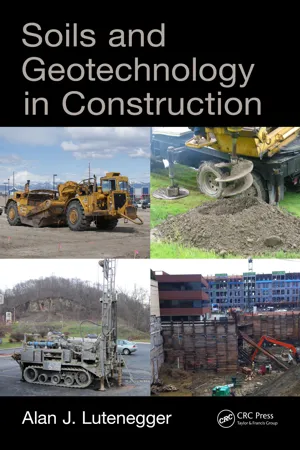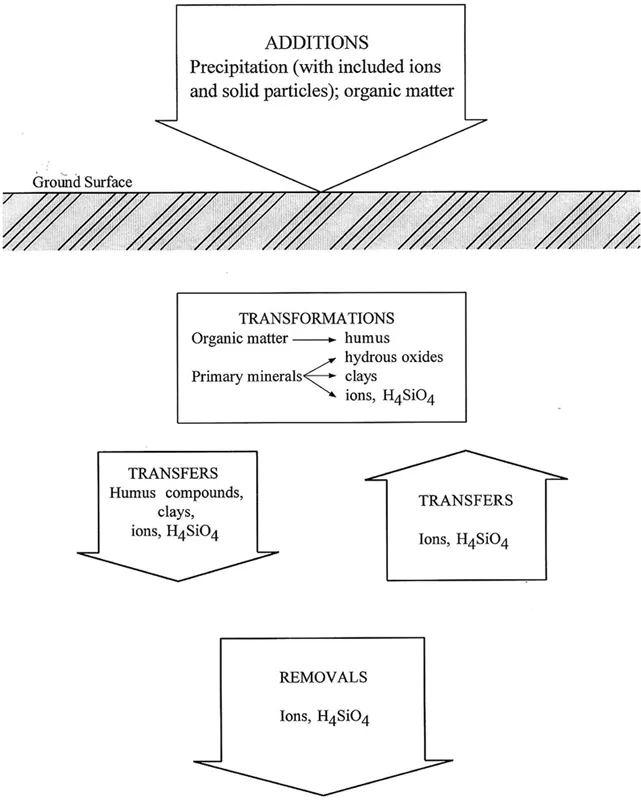
This is a test
- 487 pages
- English
- ePUB (mobile friendly)
- Available on iOS & Android
eBook - ePub
Soils and Geotechnology in Construction
Book details
Book preview
Table of contents
Citations
About This Book
This book covers the field of applied geotechnology related to all aspects of construction in ground, including compacted fill, excavations, ground improvement, foundations, earth retaining systems and geotechnical site characterization. It suits the first year of a graduate course on ground improvement and geoconstruction and will suit practicing engineers, both consultants and contractors.
Distinctively it covers the identification of problematic soils and appropriate mitigation measures, and the inspection of ground construction work. It combines the technical and the practical in applied geotechnology.
Frequently asked questions
At the moment all of our mobile-responsive ePub books are available to download via the app. Most of our PDFs are also available to download and we're working on making the final remaining ones downloadable now. Learn more here.
Both plans give you full access to the library and all of Perlego’s features. The only differences are the price and subscription period: With the annual plan you’ll save around 30% compared to 12 months on the monthly plan.
We are an online textbook subscription service, where you can get access to an entire online library for less than the price of a single book per month. With over 1 million books across 1000+ topics, we’ve got you covered! Learn more here.
Look out for the read-aloud symbol on your next book to see if you can listen to it. The read-aloud tool reads text aloud for you, highlighting the text as it is being read. You can pause it, speed it up and slow it down. Learn more here.
Yes, you can access Soils and Geotechnology in Construction by Alan J. Lutenegger in PDF and/or ePUB format, as well as other popular books in Technology & Engineering & Civil Engineering. We have over one million books available in our catalogue for you to explore.
Information
Chapter 1
Soils—The nature of ground; Soil properties and soil behavior
1.1 THE NATURE AND COMPOSITION OF SOILS
1.1.1 Types of soils
Soils consist of the assemblage of small particles of mineral matter, usually disintegrated particles derived from rock deposits. The uniqueness of soils relative to other civil engineering materials is that they are naturally formed from geologic processes and they are a composite material, made up of solid mineral matter, water, and sometimes air. Soil deposits generally fall into one of two principal categories, depending on their formation: (1) Transported Soils, and (2) Residual Soils.
1.1.1.1 Transported soils
Transported Soils are those soils whose particles are produced in one location and then transported by various geologic processes and deposited in another location. An example would be mid-continental glacial deposits in the U.S. that were produced in Canada during the Ice Age and then transported by glaciers to the Midwest. As the ice melted and retreated, the materials were deposited in their present location, leaving engineers to deal with this material as it currently exists. The geologic processes most responsible for Transported Soils include movement by wind (eolian deposits), water (alluvial, marine, and lacustrine [lake bed] deposits), ice (glacial deposits), gravity (colluvial, talus, and slope wash deposits), and combinations of these processes.
Because the original composition of a soil can vary greatly as a result of variations in the source or parent material and because the transport processes can vary over time, the range of resulting soil deposits can also vary widely. Transported Soils generally do not reflect compositional characteristics of the underlying bedrock, especially if the transport distance has been on the order of 10s or 100s of miles.
Transported Soils also can undergo post-depositional changes, i.e., alteration or weathering after deposition (Lutenegger 1995). Post-depositional processes that act on geologic deposits can include periodic freeze-thaw cycles, fluctuating ground-water levels, erosion, infiltration of water from rainfall and snow-melt, changes in water chemistry, oxidation, leaching, etc., as illustrated in Figure 1.1. These processes can alter the freshly deposited material with different intensity over time to create the current deposit that must be managed.
Depending on the mechanisms involved and the time, the alteration of a fresh geologic deposit may be slight—for example, the leaching of carbonates—or it may be severe—for example, the complete weathering of individual particles into a new material.

Figure 1.1 Post-depositional weathering processes for transported soils. (From Lutenegger, A.J., Transport. Res. Rec., 1479, 61–74, 1995. Reproduced with permission from SAGE.)
1.1.1.2 Residual soils
Unlike Transported Soils, Residual Soils are those soils which are formed in place as a result of chemical and physical weathering of the underlying bedrock or weathering of an underlying geologic deposit. The resulting deposit derives much of its compositional characteristics directly from the underlying material. Because of the wide variety of bedrocks and other deposits and their composition, residual soils can be highly variable over short distances, especially if the underlying material is also highly variable at a site. One of the most important regions in the continental U.S. containing Residual Soils developed from bedrock is the Piedmont Physiographic Region of the eastern and southeastern U.S. that extends from about Philadelphia, Pennsylvania in the North to south of Atlanta, Georgia in the South.
Residual Soils occur in many parts of the world: in Asia, South America, and Africa in moderate-to-temperate climates. In certain areas, some Residual Soils are sometimes referred ...
Table of contents
- Cover
- Half Title
- Title Page
- Copyright Page
- Table of Contents
- About the Author
- 1 Soils—The nature of ground; Soil properties and soil behavior
- 2 Geotechnical site investigations
- 3 General construction earthwork
- 4 Compaction of soils
- 5 Excavations and trenching
- 6 Foundations
- 7 Earth retention and earth anchors
- 8 Ground improvement
- 9 Problematic soils
- 10 Inspection of geoconstruction
- Index